|
|
Post by Jussi Ekholm on Dec 21, 2013 20:10:47 GMT
Well I got bit sidetracked on another forum when there was talk about very large twohanded swords of variours cultures with very long blades. I thought I'll post this here, as Odachi are among my favorite types (smaller ones, not the monster swords I'll list here). Odachi 大太刀 (large tachi) is term commonly used when blade is over 90 cm in length. There are few Odachi in Japan that have blade near or over 2 meters. (I'm at my parents for the holidays, and I might have bit more information in my books but can't access them now) Most of these swords are famous artifacts. 祢々切丸 - Nenekirimaru (Nambokucho 1332-1394) Total length: 324 cm Blade length: I've seen mention c. 215 cm 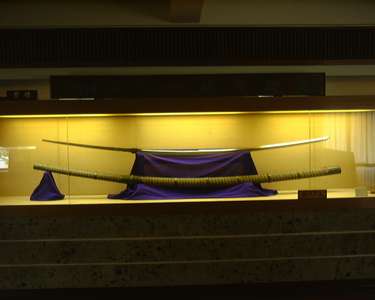 太郎丸 - Taroumaru (Kamakura period 1184 - 1332) Total length: 262 cm Blade length: 180 cm Weight: 7,2 kg  志田の大太刀 - Shida no odachi (dated 1415) Blade length: 220 cm 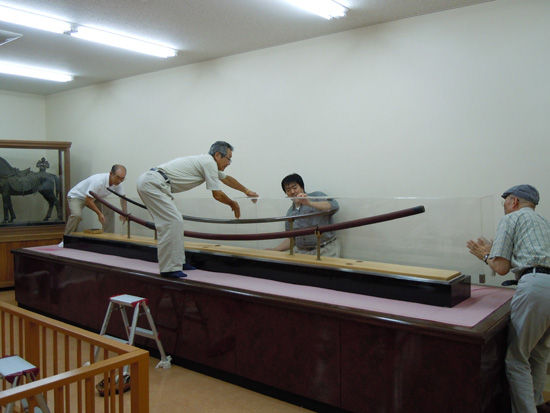 太郎太刀 - Taroutachi (It is described being sword Makara Naotaka used in 1570 at battle of Anegawa) Blade length: 220 cm Weight: 4,5 kg 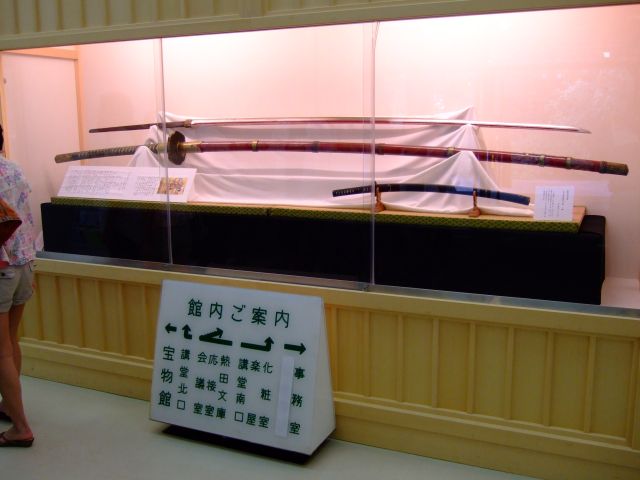 Odachi made by 三家正吉 Sanie Masayoshi (dated 1843) Blade length: 224 cm  備州長船法光 - Bishu Osafune Norimitsu (dated 1447) Total length: 377 cm Blade length: 227 cm Weight: 14,5 kg  |
|
|
|
Post by William Swiger on Dec 21, 2013 20:27:16 GMT
Great pictures - thanks for posting these.
|
|
|
|
Post by johnwalter on Dec 21, 2013 20:57:50 GMT
Wow!
|
|
|
|
Post by napper on Dec 21, 2013 21:07:01 GMT
Great Post Jussi, always wondering how they handled these monsters :shock:
|
|
|
|
Post by Novice_Surgery on Dec 21, 2013 22:03:06 GMT
Awesome blades. That one tsuka is so thick and huge. Great pics.
|
|
|
|
Post by Vitro on Dec 21, 2013 22:48:13 GMT
|
|
|
|
Post by american samurai on Dec 22, 2013 9:08:23 GMT
|
|
|
|
Post by Bob B on Dec 24, 2013 6:11:11 GMT
Gotta kinda feel bad for a horse that got whacked with one of those.
Bob
|
|
|
|
Post by The Lone Stranger on Dec 24, 2013 15:42:18 GMT
Y'know, I was just talking about these the other day with a friend. As far as I know, many of the really huge ones were purely temple offerings. Does anyone know about any of these actually being used?
|
|
|
|
Post by Bob B on Dec 24, 2013 21:58:29 GMT
I believe Stephen Turnbull mentioned them in a book or two being used against cavalry horses. I'll doublecheck that. That's where I got the idea that made me post about horses. Cutting the legs out from under them. Give me a day or two to scour a reference when I can. Should be interesting.
Bob
|
|
|
|
Post by Bob B on Dec 25, 2013 2:28:07 GMT
Welp, here's what I have so far. On page 27 of "Japanese Spears, Polearms and their Use in Old Japan" by Roald & Patricia Knutsen , the last paragraph of the page talks about how the O-dachi and No-dachi had become popular with the bushi from 1100-1450. On page 31 is a half page and it seems it is speculation that a warrior on foot with a No-dachi would aim at the oncoming mounted warriors horse particularly the legs. Here's the actual quote
" On foot, in particular, when facing an oncoming mounted warrior, the bushi may first have aimed his scything cut at the animal's legs in order to bring down the rider to his destruction, and some contemporary descriptions of fighting in narrow constricted conditions tell us exactly this".
Alright, this quote comes in context of using the weapon in close quarters just so you know. I don't want to type the whole page...lol. Also, as the Lone Ranger aluded, this page is talking of one of three blades housed at O-yama-zumi Shrine. The history of the blades (No-dachi) and the owners of all three are mentioned here in this chapter of the book. Also, I grabbed two of turnbul's book down off the shelf "Samurai Warfare" pgs 47 and 55 mention No-dachi being used FROM horseback. I'm still curious so I'll keep browsing. I have Karl F Friday's books too who I really think is great. So-so far that's what I've dug up.
Bob
|
|
|
|
Post by randomnobody on Dec 25, 2013 3:10:26 GMT
Even in the original post in this thread, "Taroutachi" (the one with the four guys all checking it out) is said to be "described as" used by a specific individual in a specific battle. Whether there is an English-language (or any other than Japanese, or even Japanese for that matter) source or record of this person, sword, and/or battle is something one more savvy than I should look into.
Still, it says the blade is 220 cm, which is about eight feet via quick guesstimate, (edit: I did real math, 7.21~ feet; so 7' 2.5" ish) which is absolutely ridiculously huge.
|
|
|
|
Post by american samurai on Dec 25, 2013 7:07:53 GMT
Nope, no evidence at all that samurai ever used these huge swords. :lol:  |
|
|
|
Post by randomnobody on Dec 25, 2013 7:17:04 GMT
Well, considering that he's kneeling, it doesn't really look all that big. The tsuka is quite large compared to what looks to be a "normal" sword there on his hip, but the biggun doesn't look quite six feet long overall. Less, even, as were he standing it looks like it would be shoulder-height on him, figure he's about 5'8"?
Still a nice, big sword. I want one.
|
|
|
|
Post by american samurai on Dec 25, 2013 7:56:31 GMT
That is a huge /massive sword, see how his his hand does not even go around the saya.  |
|
|
|
Post by Bob B on Dec 25, 2013 9:00:02 GMT
Random,
The swords I referenced at the shrine were nagasa lengths of 31", 40", and 59". Not these pictured in the post. My looking into this is for more than the purpose of these particular giant No-dachi. I'm looking for how one might of used them. I see the question is posed about these in particular, but my comments on "feeling sorry for the horses...etc" is what I'm looking at. That's where the question for me is premised. My mentioning history and owners wasn't a justification. That was never in my mind. I don't know what made you jump on that. The sentence was a side note near the end of the paragraph without any supporting lines to it. Just a interesting sidenote, thanks.
Bob
|
|
|
|
Post by american samurai on Dec 25, 2013 11:44:46 GMT
From Guido Schiller: ("The Nodachi originates in the Heian period, where this term was used to describe a long sword used for fighting - to distinguish it from the Gijô-Tachi used by court nobles for mostly ceremonial reasons. Length wasn't a determining factor. Even what we now call Kenukigata-Tachi was called "Nodachi" back then, and Gijô-Tachi is in current literature described as Kazari-Tachi ("decorative" Tachi). Today's Tantô was the Koshigatana ("hip sword") back then. In the Nambokuchô period terminology changed again. Tachi became shorter for civilian use (Kodachi, what now would be classified as Wakizashi due to its length), and the Ôdachi with a cutting length of four, five and even six Shaku. They were also called Seoi-Nodachi ("Nodachi carried on the back") or Nagadachi ("long Tachi", what some scholars believe became the Nagamaki). These huge weapons were occasionally mounted in disposable scabbards. Very few of these great blades have survived in their original length since later generations cut them down to a convenient size. However, several votive offerings in temples and shrines remain; one excellent blade of six feet, made by Tomoyuki of Bungo, is in the collection of the Oyamazumi shrine and has been designated a national treasure. With the advent of the Uchigatana a kind of "standardization" took place, and long swords were either named simply Tachi or Katana, medium swords Wakizashi and daggers Tantô. When we say "Nodachi" we actually mean the "Ôdachi", but the former term is more widely used. (On-yomi in caps) "Tachi" is made up from the characters TAI/TA/futo(i) = thick, fat & TÔ/katana = sword, knife; the reading CHI is an exception and usually not found in dictionaries. The YA/no in "Nodachi" means "wild", and the DAI/TAI/ô(kii) in Ôdachi "big" - so "Nodachi" means literally "wild fat sword" .") 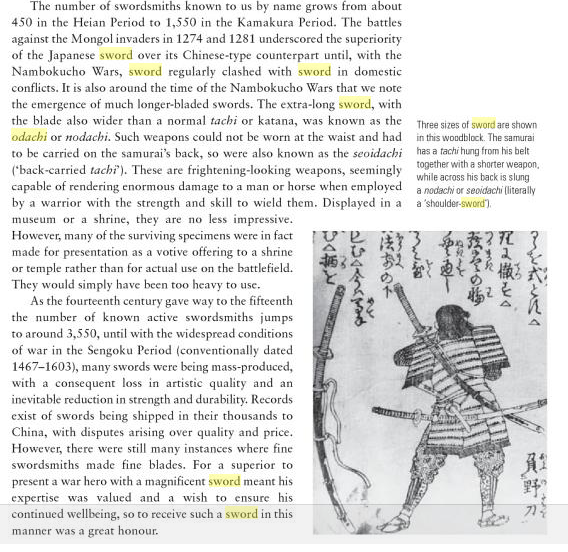 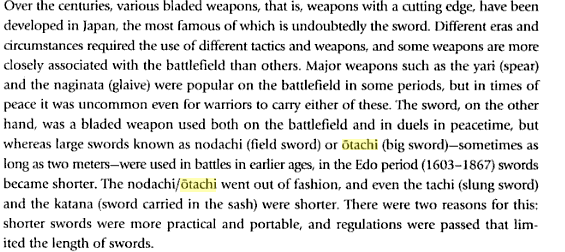 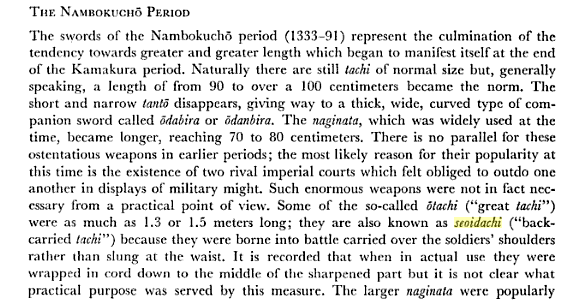  |
|
|
|
Post by randomnobody on Dec 25, 2013 12:49:26 GMT
My post wasn't directed to you at all, but intended as a follow-up for the previous poster, who you were addressing with that information. I know it was just a quick mention at the end of a paragraph that I referred to, that's why I mentioned it: people were likely to have missed it. I only meant to bring attention to the one example already given in within to your post. I want jumping on anything, just trying to highlight something. 'Murcin samyoorye guy: Yeah, it's chubby, but not very tall. Kind of like me as a kid.  |
|
|
|
Post by Bob B on Dec 25, 2013 16:39:09 GMT
Random,
Sounds good, thanks. Looks like American Samurai did some wonderful digging...I'm done. Time to drink eggnog with some Fireball in it. Have a wonderful holidays you all!!
Bob
|
|
|
|
Post by randomnobody on Dec 25, 2013 17:22:16 GMT
Yeah, that's a great photo he found, and the book pages are even better. I feel like I've seen it before, but heck, I'd never have been able to find it. :oops:
I've just realized my phone changed a few words on me, and now I can't remember what they were supposed to be...so hopefully enough of my intended post survived to make some kind of sense. :x
|
|

